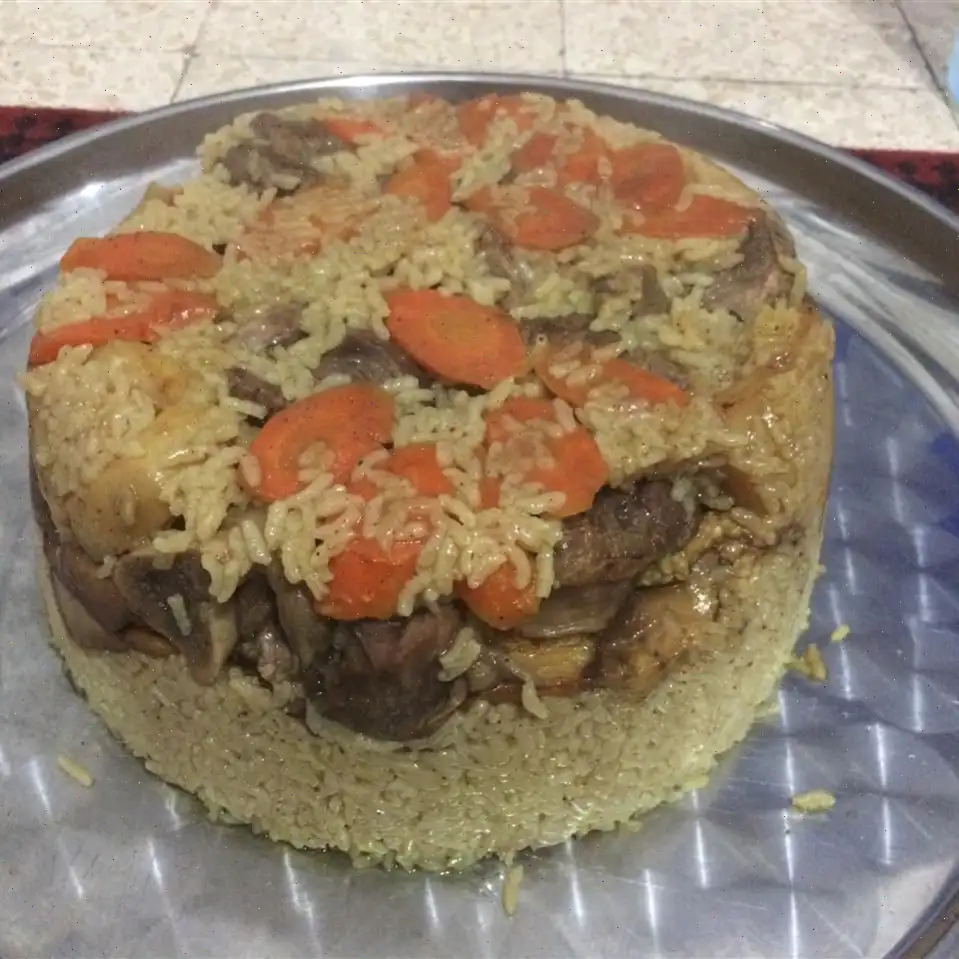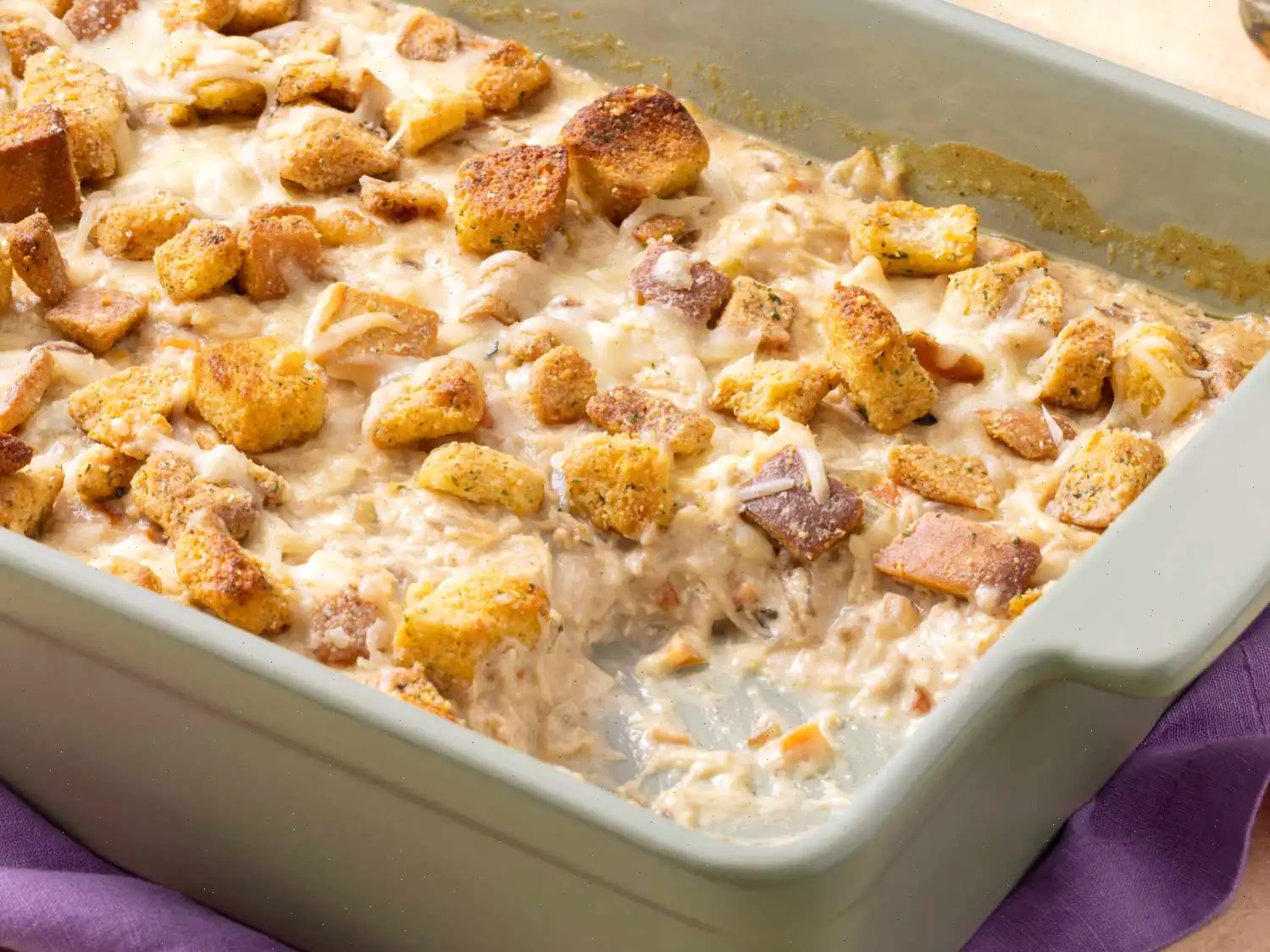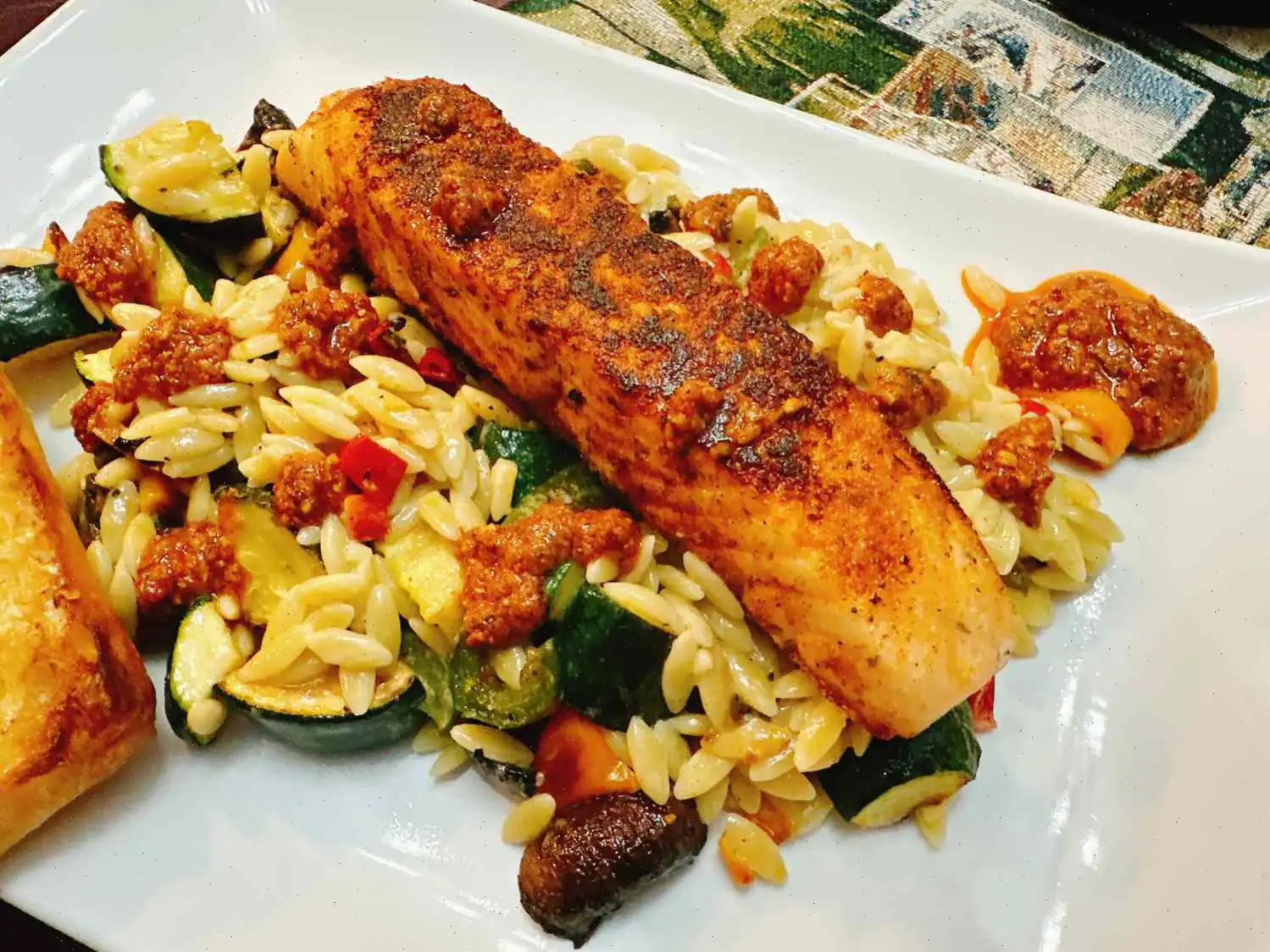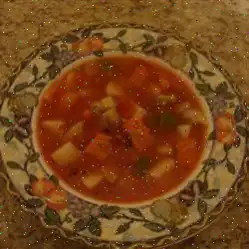
Maqluba Recipe
Ingredients
- 1 (4-pound) whole chicken, cut into pieces
- 6 cups water
- 1 medium onion, quartered
- 2 tablespoons ground allspice
- teaspoon ground cardamom
- 3 whole cardamom seeds
- 4 whole cloves
- 3 bay leaves
- 2 cups uncooked basmati rice, rinsed and drained
- 3 tablespoons vegetable oil
- 1 large potato, sliced into rounds
- 1 large head cauliflower, separated into florets
- 2 medium tomatoes, diced
Directions
- Place the chicken in a large pot along with 6 cups of water, onion, 2 tablespoons of allspice, ground cardamom, cardamom seeds, whole cloves, and bay leaves. Bring to a boil and cook for about 40 minutes, or until the chicken becomes tender. Once done, remove the chicken, strain the broth, and set it aside.
- While the chicken is cooking, soak the rice in water. Drain the rice when the chicken is almost done, then stir in 1 tablespoons of allspice to the rice.
- Heat vegetable oil in a skillet over medium-high heat. Fry the potato slices and cauliflower florets in the hot oil until browned, but they do not need to be fully cooked.
- Layer the fried potato slices at the bottom of a separate pot to prevent the rice from sticking. Then add the cauliflower and tomatoes on top. Sprinkle a handful of rice over the vegetables.
- Remove the bones from the cooked chicken and place the meat in the pot on top of the vegetables. Cover with the remaining rice.
- Pour the reserved broth into the pot until it reaches about inch above the level of the rice. Cover the pot and cook over medium-low heat for about 1 hour, or until the rice becomes tender.
- Once done, uncover the pot and place a large round tray on top. Invert the pot so that the tray is now on the bottom. Let the dish rest for about 5 minutes before slowly removing the pot, allowing the food to gently fall onto the tray.
Cook's Note
You can substitute 1 large eggplant for the cauliflower or use both. Slice the eggplant into rounds, cutting the larger pieces in half. If using both, add the eggplant along with the cauliflower in the pot.
Nutrition Facts (per serving)
- Calories: 767
- Total Fat: 28g (36% Daily Value)
- Saturated Fat: 7g (34% Daily Value)
- Cholesterol: 82mg (27% Daily Value)
- Sodium: 131mg (6% Daily Value)
- Total Carbohydrates: 90g (33% Daily Value)
- Dietary Fiber: 8g (28% Daily Value)
- Total Sugars: 6g
- Protein: 39g (78% Daily Value)
- Vitamin C: 85mg (94% Daily Value)
- Calcium: 114mg (9% Daily Value)
- Iron: 6mg (32% Daily Value)
- Potassium: 1123mg (24% Daily Value)
* Percent Daily Values are based on a 2,000-calorie diet. Your daily values may be higher or lower depending on your calorie needs.
** Nutrient information is not available for all ingredients. Amount is based on available nutrient data. (-) Information is not currently available for this nutrient. If you are following a medically restrictive diet, please consult your doctor or registered dietitian before preparing this recipe for personal consumption.
Maqluba, a traditional Middle Eastern dish, is a comforting and flavorful one-pot meal made by layering rice, chicken, vegetables, and spices, then cooking everything together and flipping the pot upside down for a dramatic and mouthwatering presentation. The result is a beautifully arranged platter of tender chicken, perfectly cooked rice, and flavorful vegetables, with each bite packed with spices that make this dish a crowd favorite.
History and Origin
Maqluba, which translates to "upside down" in Arabic, is believed to have originated in the Levant region, which includes countries like Jordan, Palestine, Lebanon, and Syria. This dish has been a staple in the region for centuries, typically served on special occasions, family gatherings, and celebrations. The act of flipping the pot to reveal its contents is a dramatic and festive part of the meal, symbolizing the joy and hospitality associated with Middle Eastern dining traditions.
Regional Variations
Although Maqluba is enjoyed across many Middle Eastern countries, each region has its own twist on the dish. In Jordan, it is commonly made with cauliflower, while Palestinians might use eggplant or a combination of both. In some parts of Syria, the addition of nuts such as almonds or pine nuts is a popular way to elevate the dish. The choice of meat also varies, with lamb being a common alternative to chicken, and some versions even incorporate ground lamb or beef mixed into the rice layers. The spices too can differ, with variations in the use of allspice, cinnamon, turmeric, and saffron to create unique flavors depending on the region.
What Makes Maqluba Unique?
While Maqluba shares similarities with other rice and meat dishes, its signature feature is the method of cooking and serving. Unlike typical rice pilafs or casseroles, Maqluba is cooked in a pot and then flipped upside down, which allows the rice and vegetables to be molded together in an impressive, cohesive structure. This method of presentation is not only visually striking but also helps the flavors meld together as the ingredients steam and simmer. The act of flipping the pot adds an element of drama and tradition, making Maqluba more than just a meal, but a celebration of culture and togetherness.
Where Is Maqluba Typically Served?
Maqluba is often served during large family gatherings, special occasions, and festive events. In many Middle Eastern homes, it is considered a dish of honor, typically placed at the center of the table for everyone to share. The communal nature of the dish encourages social interaction and the joy of eating together. It is particularly popular during religious holidays such as Ramadan and Eid, as well as weddings and other celebrations. The dish's filling nature makes it ideal for feeding large groups, and its vibrant presentation always impresses guests.
Interesting Facts About Maqluba
- The method of flipping the pot upside down is said to symbolize the reversal of fate and fortune, adding a layer of meaning to the dish.
- In some regions, Maqluba is traditionally prepared using lamb, a meat considered a symbol of luxury and celebration.
- Maqluba is often accompanied by a side of yogurt or a salad, balancing the rich and hearty flavors of the dish.
- Maqluba has also made its way to other parts of the world, with Middle Eastern diaspora communities adapting it to local ingredients and tastes.
Whether youre enjoying it for a special occasion or just a cozy family meal, Maqluba is a beautiful and delicious way to experience the rich culinary traditions of the Middle East.
You can listen to this recipe in AI audio format. Simply click the play button below to listen to the content in a format that suits you best. It’s a great way to absorb information on the go!
FAQ about Maqluba Recipe
Comments
Pamela Hernandez
08/29/2022 03:01:33 AM
This meal is fantastic as a complete package. The aroma it gives off while cooking is delightful. Placing it on an elegant platter enhances its beauty. Plus, it's incredibly easy to prepare.
Kelly Nguyen
03/28/2024 02:22:04 AM
I recently shared this recipe and wanted to mention that adding chopped carrots to the dish is a delightful addition. The natural sweetness they bring really enhances the flavors. Additionally, I usually include Maggi cubes (chicken bouillon cubes) in my cooking. I suggest using at least one cube, but remember to adjust the salt level after adding them because chicken stock is already salted. Over time, I've found that adding a bit more spice elevates the dish even more. Consider incorporating 1 tsp of cumin or curry for an extra depth of flavor. It's a fantastic enhancement!
Sharon Roberts
09/28/2024 06:47:59 PM
This dish is a favorite among our family members. I like to include a few extra ingredients. Instead of just cauliflower for veggies, I also recommend adding eggplant. While cauliflower is the more traditional choice, my husband enjoys broccoli, which adds a great flavor. I also mix in chickpeas with the vegetables. For spices, I use ground cinnamon, salt, and chicken bouillon. I incorporate these spices while boiling the chicken, and I also sprinkle them over the rice before adding it to the pot. Lastly, I suggest topping the dish with toasted slivered almonds right before serving.
Raymond Phillips
09/17/2022 04:00:42 AM
Great recipe! I typically combine rice and cauliflower, and I substitute potatoes with fried eggplant layered between the chicken and rice. When I invert the dish (maklooba), I toast pine nuts until golden brown and sprinkle them on top.
Brandon Flores
06/23/2023 10:16:39 AM
I substituted chicken breast for the original meat, and omitted the tomatoes. The dish had a nice flavor, though I think it could benefit from a bit of added salt next time.
Nathan Adams
06/02/2024 02:27:47 AM
I recently tried a version of this dish with a friend from Jordan, and it was absolutely incredible. It was my first time tasting Arabic cuisine, and I was blown away. My friend expertly stuffed the bird with a flavorful mixture of spiced rice and ground lamb, along with fried cauliflower and eggplant. I suspect there was some turmeric in the mix as well. This meal was prepared for a post-Ramadan feast, and it was a truly special experience. Thank you for sharing this recipe!
Frank Nguyen
07/05/2023 10:57:12 PM
My Jordanian husband prepares this dish frequently. I prefer boneless, skinless chicken breast over chicken with bones, and he adjusts the cooking time accordingly. He also adds a pinch of saffron when soaking the rice, which enhances the flavor beautifully.
Virginia Flores
08/14/2022 08:30:48 PM
This dish is absolutely fantastic! I admit I substituted a 10-pound turkey for the chicken (that's what I had on hand) and doubled the other ingredients, but the result was simply delicious. It might even be better than if I had used chicken.
Susan Young
12/07/2024 01:04:41 PM
Excellent recipe. Thank you.
Ronald Baker
08/17/2024 01:08:30 AM
Thank you for sharing your recipe! When I lived in Jordan for two years, my ex-mother-in-law would make this dish for me once a week when I was pregnant. I know it was a lot, but I absolutely loved it! And it had to be paired with lamb, no other way!
Stephen Robinson
01/23/2025 10:23:56 PM
I would rather try different recipes.
Kimberly Adams
08/20/2023 03:26:56 AM
Great recipe! Thank you. Although it requires a significant amount of time to prepare, the end results are definitely worth it.
Frank Martin
02/16/2024 07:33:28 AM
This is definitely the best maklouba recipe I've come across. It closely resembles the way my Jordanian in-laws prepare it.
Diane Nguyen
03/21/2024 11:12:19 PM
Makloubeh is a classic Middle Eastern dish that I first tried in Jordan. The memory of my mother preparing it has inspired me to now cook it for my own children. Despite requiring a few steps, it is relatively simple to make and incredibly delicious. The added bonus is the wonderful aroma that fills the house while it simmers on the stove!
Eric Jackson
04/03/2024 05:37:42 AM
Excellent maqlooba recipe! I really enjoyed the addition of tomatoes. I decided to make a half batch and it turned out perfectly.
Jonathan Green
03/27/2025 11:28:31 PM
The fragrance and flavor are delightful. Our guests were very impressed.
Kelly Roberts
05/18/2025 02:23:55 AM
Excellent recipe, thank you so much! I first tried this dish during my trip to Palestine, and your recipe surpassed the one I had there. I made it with eggplant and cauliflower, and noticed some variations with carrots that also turned out great.








